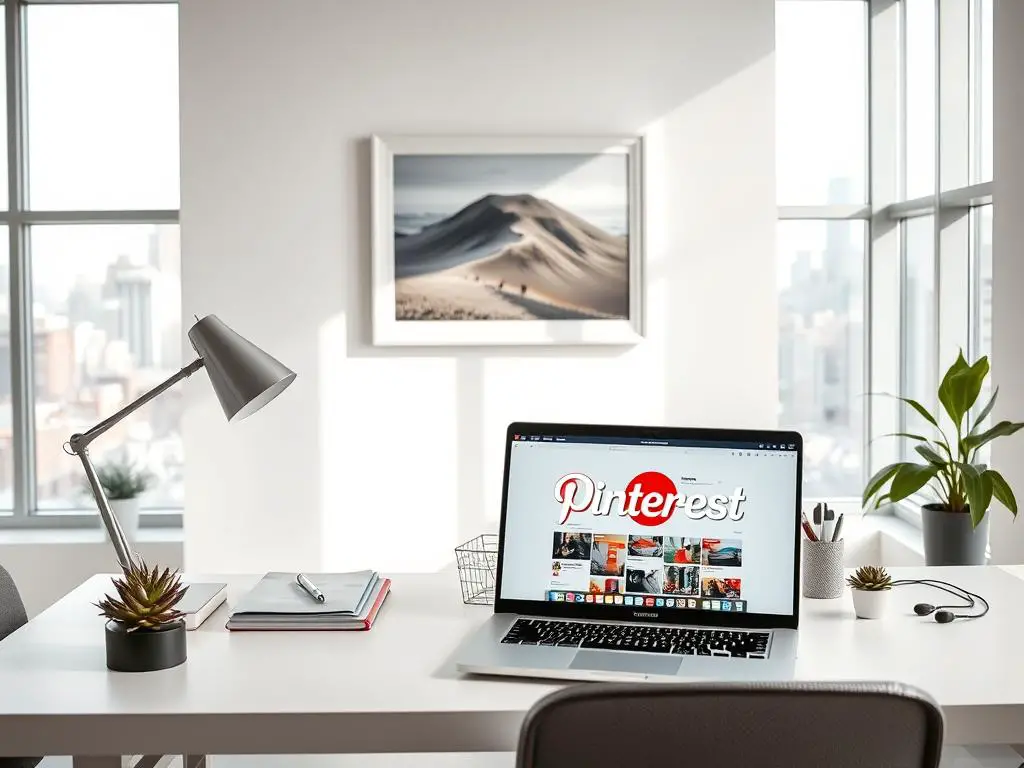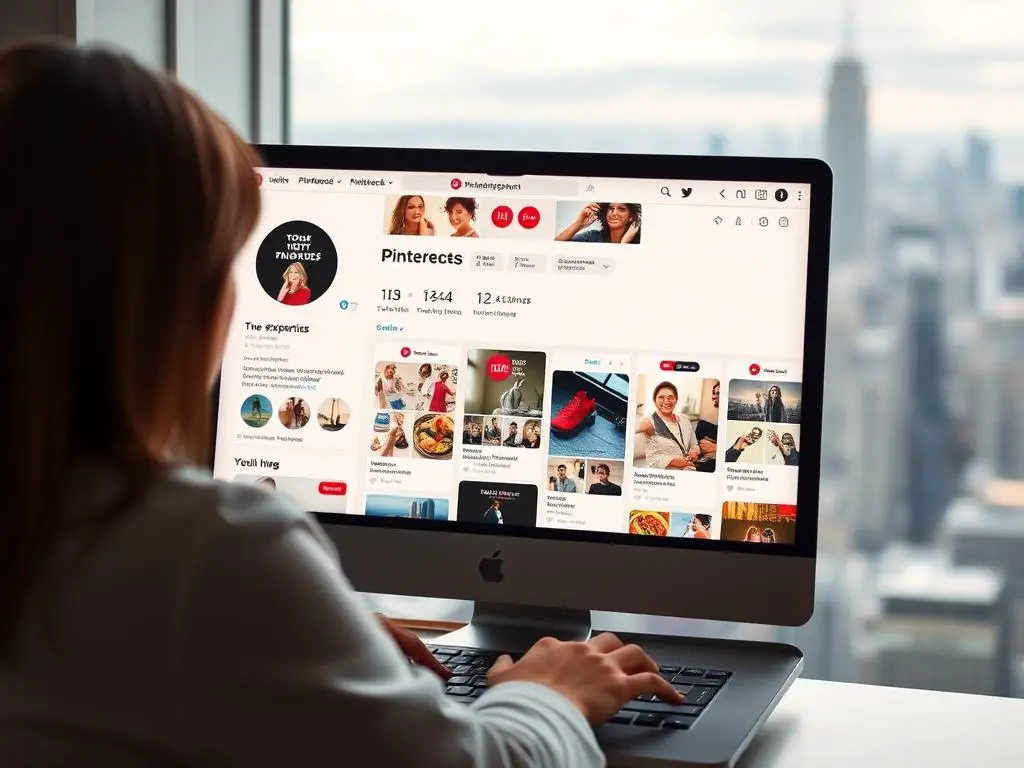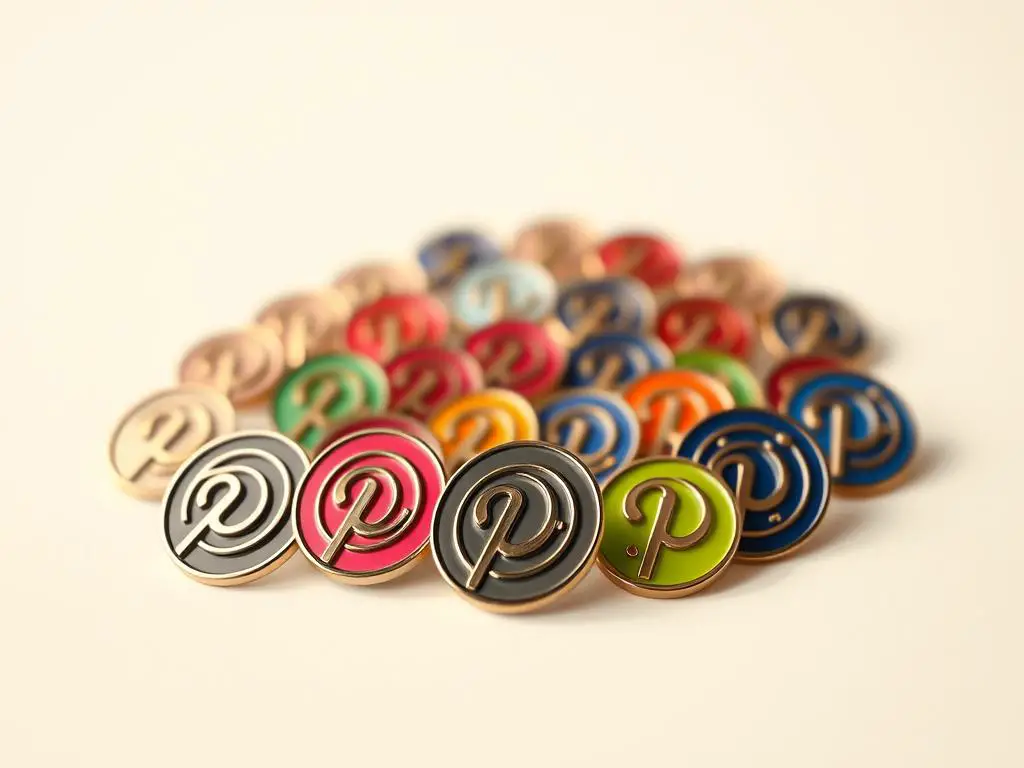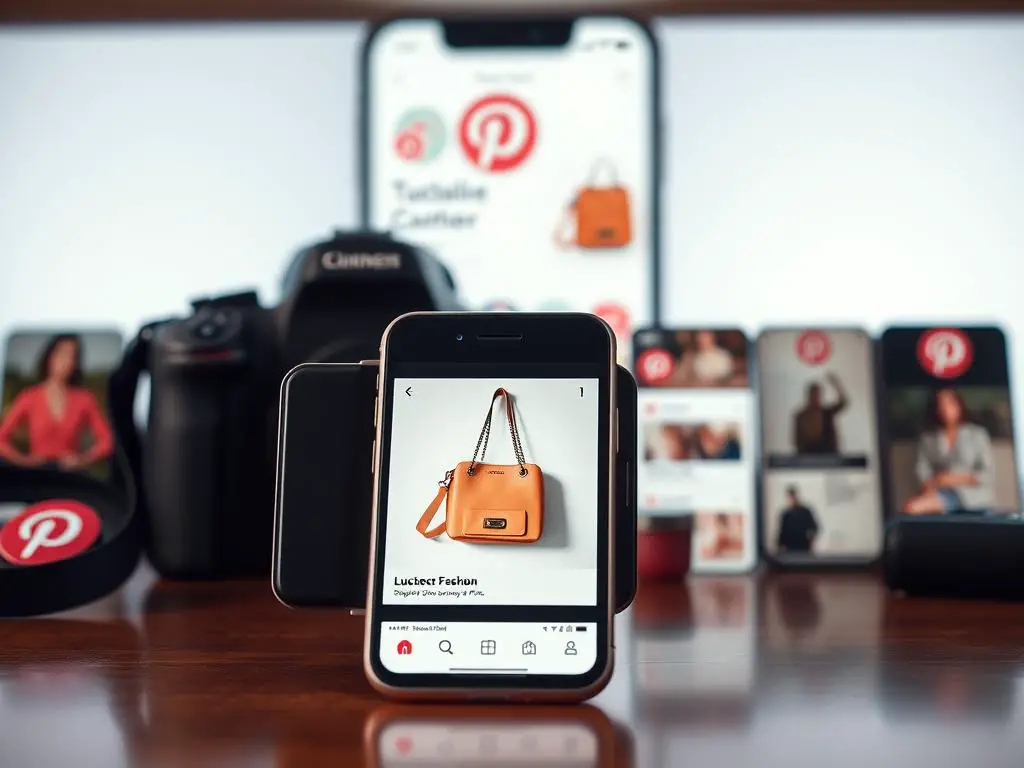Have you ever wondered how a simple platform can turn into a powerful income generator? With over 500 million active users and a revenue surpassing $2.5 billion, Pinterest has evolved into more than just a place for inspiration. It’s now a visual search engine where 80% of users come with purchase intent.
What makes this platform unique is its ability to create passive income streams. Evergreen content continues to drive traffic and sales long after it’s posted. Whether you’re exploring affiliate marketing, selling products, or leveraging sponsored content, the opportunities are vast.
With users spending an average of 7 minutes per session, the potential for conversions is immense. This guide will walk you through proven strategies to build a sustainable income stream. Ready to learn how to make money on this thriving platform? Let’s dive in!
Key Takeaways
- Pinterest has over 500 million active users and generates $2.5 billion in revenue.
- 80% of users come with purchase intent, making it a powerful sales tool.
- Evergreen content creates long-term passive income opportunities.
- Strategies include affiliate marketing, product sales, and sponsored content.
- Users spend an average of 7 minutes per session, increasing conversion chances.
Why Pinterest is a Goldmine for Monetization in 2025
The digital landscape is evolving, and visual discovery is leading the charge. With over 2 billion monthly searches, this platform has become a visual search engine that connects users with products and ideas. Its unique approach to content discovery makes it a powerful tool for creators and businesses alike.
The Rise of Visual Search and Shopping
Visual search is transforming how users find and buy products online. Unlike traditional search engines, this platform focuses on images and videos, making it easier for users to discover what they need. Buyable Pins, for example, drive 2.3x higher conversion rates than standard product links.
This shift is driven by user behavior. Gen Z and millennials make up 60% of the target audience, with an average household income of $75k+. These users are more likely to engage with visually appealing content, especially when it includes product tags or links.
Pinterest’s Algorithm and User Behavior in 2025
The platform’s algorithm prioritizes content that resonates with users. Keyword-rich pins with 1000x1500px vertical images perform best. Video pins, in particular, see 40% longer engagement times, making them a favorite for creators.
User demographics are also shifting. While 70% of users are female, male-dominated niches like tech and gaming are growing by 45%. This expansion opens new opportunities for creators to tap into diverse markets.
“Pinterest’s 7-day content shelf life ensures your pins stay relevant longer than posts on other platforms.”
By leveraging Pinterest analytics, creators can track trends and optimize their strategies. For example, searches for “AI home decor” have grown 110% year-over-year, highlighting the importance of staying ahead of trends.
Setting Up Your Pinterest Business Account
Unlocking the full potential of this platform starts with setting up the right account. A business account provides advanced features and tools to help you grow your reach and earnings. Whether you’re a creator or a brand, this step is essential for success.

How to Convert to a Business Account
Converting your personal account to a business account is simple. Start by logging into your profile and navigating to the settings. From there, select the option to switch to a business account. You’ll gain access to features like Shopify integration, which automatically generates product pins.
Once converted, you can install the Pinterest Tag to track conversions. This tool helps you monitor average order values and optimize your strategy. Verified merchants also enjoy a 33% boost in visibility on Pinterest Shopping.
Benefits of a Pinterest Business Profile
A business profile offers numerous advantages. You’ll receive 90-day analytics, revealing top-performing pins and peak engagement times. This data helps you refine your content strategy for better results.
Setting up the Merchant Center allows for automatic Rich Pin generation, saving you time and effort. Additionally, Pinterest API access enables bulk pin scheduling through tools like Tailwind. Exclusive features like dynamic retargeting ads and AR try-on pins further enhance your marketing efforts.
“A business account is your gateway to advanced features and higher visibility.”
By leveraging these tools, you can create a professional presence and maximize your earnings. The right setup ensures you’re ready to take full advantage of this platform’s potential.
Optimizing Your Pinterest Profile for Success
Your profile is the first impression you make on this platform. A well-crafted profile not only attracts your audience but also boosts your visibility in search results. Start by optimizing your bio and boards with relevant keywords to ensure you’re easily discoverable.

Keyword-Rich Profile and Board Descriptions
Your bio should clearly communicate your niche and value. Use a template like “[Niches] Expert | [Value Proposition] | Est. 2025” to create a professional introduction. For board descriptions, integrate keywords naturally to avoid penalties for keyword stuffing, which begins at a 4.7% density threshold.
Tools like SEMrush can provide real-time keyword suggestions, helping you stay ahead of trends. For example, a home decor account grew by 15k followers using a board titled “Cottagecore Lighting Ideas.”
Creating Niche-Specific Boards
Profiles with 5-7 niche boards see 89% higher follower retention. Use a naming formula like “Primary Keyword + Secondary Keyword + Year” to make your boards stand out. Organize them with tools like Canva mood boards or Airtable content calendars for consistency.
Avoid common mistakes like creating overbroad boards or posting inconsistently. Focus on a specific niche to attract a dedicated audience and drive traffic to your website.
“A well-organized profile is the backbone of your success on this platform.”
By following these strategies, you’ll create a profile that not only attracts followers but also converts them into loyal customers.
Creating High-Quality, Optimized Pins
Crafting pins that stand out is the key to driving engagement and conversions. A well-designed pin not only grabs attention but also encourages users to take action. To succeed, focus on both aesthetics and optimization.

Design Tips for Eye-Catching Pins
Visual appeal is crucial when creating pins. Use a vertical format with dimensions of 1000x1500px and a resolution of 72dpi. Keep the file size under 500KB to ensure fast loading times.
Follow the 20-60-20 rule for layout: 20% text overlay, 60% image, and 20% negative space. This balance ensures your content is easy to read and visually appealing. Adding a blue accent color (#1E90FF) can boost engagement by 63%.
Avoid multiple CTAs, as they can reduce engagement by 27%. Instead, focus on a single, clear call-to-action that guides users to your product or website.
Using Keywords and Hashtags Effectively
Keywords play a vital role in making your pins discoverable. Place them strategically in the title, description, and hashtags. For example, a pin titled “Modern Home Decor Ideas” should include related keywords in the description.
Hashtags should be niche-specific and relevant. Use 3-5 hashtags that align with your content, plus one trending hashtag like #AIArt2025. Avoid banned hashtags such as #makemoneyfast or #getrichquick, as they can harm your visibility.
| Element | Specifications |
|---|---|
| Dimensions | 1000x1500px |
| Resolution | 72dpi |
| File Size | Under 500KB |
| Layout | 20% text, 60% image, 20% space |
| Accent Color | #1E90FF (Blue) |
By combining these design and optimization strategies, you can create pins that not only attract attention but also drive meaningful results. Whether you’re showcasing a product or sharing valuable content, these tips will help you stand out in the visual search engine.
Affiliate Marketing on Pinterest: A Step-by-Step Guide
Affiliate marketing is a powerful way to earn income while sharing products you love. By promoting affiliate links, you can earn commissions for every sale or action generated through your efforts. This guide will walk you through choosing the right programs and designing pins that drive clicks and conversions.
Choosing the Right Affiliate Programs
Selecting the right affiliate programs is crucial for success. Look for programs that align with your niche and offer competitive commission rates. Popular options include Amazon Associates, ShareASale, and Rakuten. These platforms are Pinterest-compliant and provide a wide range of products to promote.
Disclosure requirements are also essential. The FTC mandates using #ad within the first 125 characters of your pin description. This ensures transparency and builds trust with your audience.
| Program | Commission Rate | Cookie Duration |
|---|---|---|
| Amazon Associates | 1-10% | 24 hours |
| ShareASale | 5-50% | 30 days |
| Rakuten | 3-15% | 7 days |
Designing Pins That Drive Clicks and Conversions
Your pins should be visually appealing and optimized for clicks. Use high-quality images with a vertical format (1000x1500px) and include a clear call-to-action. Adding a blue accent color (#1E90FF) can boost engagement by 63%.
Embedding affiliate links with tracking IDs, like Skimlinks, ensures accurate performance tracking. For example, one creator earned $4,287/month by promoting AI tools through optimized pins.
“A well-designed pin is the bridge between inspiration and action.”
Finally, ensure legal compliance by including disclaimers and GDPR notices. Set up UTM parameters to track Pinterest traffic and retarget users with sequence ads for abandoned carts. By following these steps, you can turn affiliate marketing into a reliable income stream.
Selling Your Own Products on Pinterest
Turning your products into a visual shopping experience can significantly boost sales. This platform offers tools like Pinterest Shopping and Buyable Pins to help you showcase your offerings effectively. With the right setup, you can turn your business into a thriving online store.

Setting Up Pinterest Shopping and Buyable Pins
To get started, connect your Shopify or WooCommerce store to Pinterest. This integration allows you to create Buyable Pins, which enable users to purchase directly from your site. Shopify stores using Buyable Pins see a 23% higher average order value (AOV).
Dynamic retargeting can further enhance your results. By setting up retargeting ads, you can achieve a 3x return on ad spend (ROAS). This strategy is particularly effective for recovering abandoned carts and driving repeat purchases.
Using Rich Pins to Showcase Product Details
Rich Pins automatically pull product information from your website, including pricing, availability, and descriptions. They increase conversion rates by 41%, making them a must-have for any business on this platform.
Optimize your product pins with lifestyle images and 3D models. These visuals make your products more appealing and increase engagement. Daily inventory updates ensure your listings are always accurate, prioritizing popular variants.
| Optimization Tip | Impact |
|---|---|
| Lifestyle Images | Boosts engagement by 27% |
| 3D Model Integration | Increases click-through rates by 35% |
| Daily Inventory Updates | Reduces errors by 50% |
“Rich Pins transform your product listings into a seamless shopping experience, driving higher conversions.”
For EU markets, ensure your returns policy is clearly displayed. Offering a Pinterest-exclusive discount, like 15% off first pins, can also attract new customers. One eco-friendly brand scaled to $45k/month by implementing these strategies.
Collaborating with Brands for Sponsored Content
Partnering with brands can open doors to new income streams while expanding your reach. Sponsored content is a win-win for creators and businesses, offering value to your audience while generating revenue. To succeed, you’ll need a strategic approach to pitching, negotiating, and disclosing partnerships.

How to Pitch to Brands and Build Partnerships
Start by creating a professional media kit. Include 30-day stats, audience demographics, and a rate card. This toolkit is essential, as 92% of brands require Pinterest-specific media kits before collaborating.
When reaching out, use a proven email script with a 38% response rate formula. Highlight your niche, engagement metrics, and past campaign successes. Negotiation is key—consider performance-based fees or flat rates depending on the brand’s goals.
- Media Kit Template: Stats, demographics, rate card.
- Outreach Email: Highlight niche and metrics.
- Negotiation Tactics: Performance-based vs flat fees.
Disclosing Sponsored Content Properly
Transparency is non-negotiable. The FTC mandates clear disclosures, with fines up to $43,792 per violation. Place disclosures above-the-fold or within the first 125 characters of pin descriptions. Use #ad or #sponsored to ensure compliance.
After the campaign, analyze performance using earned media value calculations. Conduct quarterly reviews to maintain strong relationships with brands. This approach ensures long-term success and trust with your audience.
“Proper disclosure builds trust and ensures compliance with FTC guidelines.”
Using Pinterest Ads to Boost Your Earnings
Leveraging ads can significantly amplify your earnings on visual platforms. With the right strategy, you can reach a broader audience and drive higher conversions. This section will guide you through creating effective campaigns and optimizing performance for maximum results.
Creating Effective Ad Campaigns
Start by choosing the right ad format. Collection ads, with a 35% click-through rate (CTR), and Idea ads, with a 28% view-through rate (VTR), are top performers. These formats are designed to engage users and encourage action.
Use a budget allocation strategy that focuses on 70% retargeting and 30% prospecting. This approach ensures you’re reaching both existing and new audiences. Audience targeting is also crucial—custom segments and lookalikes can help you refine your reach.
- Creative Testing: Test 5 variants per ad group to identify the best-performing designs.
- Performance Dashboard: Integrate with Google Data Studio for real-time insights.
- Dayparting: Optimize ad delivery times for 19% efficiency gains.
Tracking and Optimizing Ad Performance
Attribution modeling is key to understanding your campaign’s impact. Use a 30-day click + 1-day view window to track conversions accurately. This method provides a comprehensive view of user behavior.
ROAS optimization involves analyzing your return on ad spend. Adjust your strategy based on performance data to maximize results. Compliance with ad policies is also essential—avoid prohibited content to maintain campaign integrity.
“Effective tracking and optimization are the cornerstones of a successful ad strategy.”
By following these steps, you can create campaigns that not only drive engagement but also deliver measurable results. Whether you’re new to ads or looking to refine your approach, these tips will help you succeed.
Conclusion: Turning Pinterest into a Passive Income Stream in 2025
Building a sustainable income stream requires strategy, consistency, and the right tools. This guide has outlined a 12-month roadmap: from setting up your account to optimizing content and scaling your efforts. By focusing on evergreen pins, you can unlock the potential for passive income that grows over time.
Imagine creating 1,000 evergreen pins that generate $3k/month. Compound growth is achievable with consistent effort. Use a final checklist to review analytics regularly and refresh content to stay relevant. Emerging trends like AR shopping try-ons and AI-generated pin variations offer exciting opportunities to innovate.
Take the 30-day implementation challenge to start your journey. Track milestones and use automation tools to streamline your workflow. One success story shows how following these strategies led to $8k/month in just six months.
With the right approach, this platform can become a reliable source of passive income. Start today, and turn your ideas into reality.
FAQ
Why is Pinterest a great platform for affiliate marketing?
Pinterest acts as a visual search engine, making it ideal for showcasing products and driving traffic through affiliate links. Its user base actively seeks inspiration, increasing the chances of conversions.
How do I set up a Pinterest business account?
Convert your personal account to a business account by accessing the settings. This unlocks features like Pinterest Analytics, Rich Pins, and the ability to run ads.
What are Rich Pins, and how do they help?
Rich Pins automatically pull product details like pricing and availability from your website. They enhance product visibility and make it easier for users to shop directly.
How can I optimize my Pinterest profile for better results?
Use keyword-rich descriptions in your profile and boards. Create niche-specific boards to attract a targeted audience and improve discoverability.
What makes a pin stand out and drive clicks?
Use high-quality images, bold text overlays, and clear calls-to-action. Incorporate relevant keywords and hashtags to improve search visibility.
How do I choose the right affiliate programs for Pinterest?
Select programs that align with your niche and audience. Look for products with high commission rates and strong visual appeal to create engaging pins.
Can I sell my own products on Pinterest?
Yes, set up Pinterest Shopping and use Buyable Pins to showcase your products. Ensure your website is linked for seamless purchases.
How do I collaborate with brands for sponsored content?
Build a strong profile with consistent engagement. Pitch to brands by showcasing your reach and audience alignment. Always disclose sponsored content properly.
Are Pinterest ads worth investing in?
Pinterest ads can boost visibility and drive traffic. Use targeted campaigns and track performance with Pinterest Analytics to optimize results.
How can I turn Pinterest into a passive income stream?
Focus on creating evergreen content, optimizing for visual search, and leveraging affiliate links and product pins. Consistency and strategy are key to long-term success.
